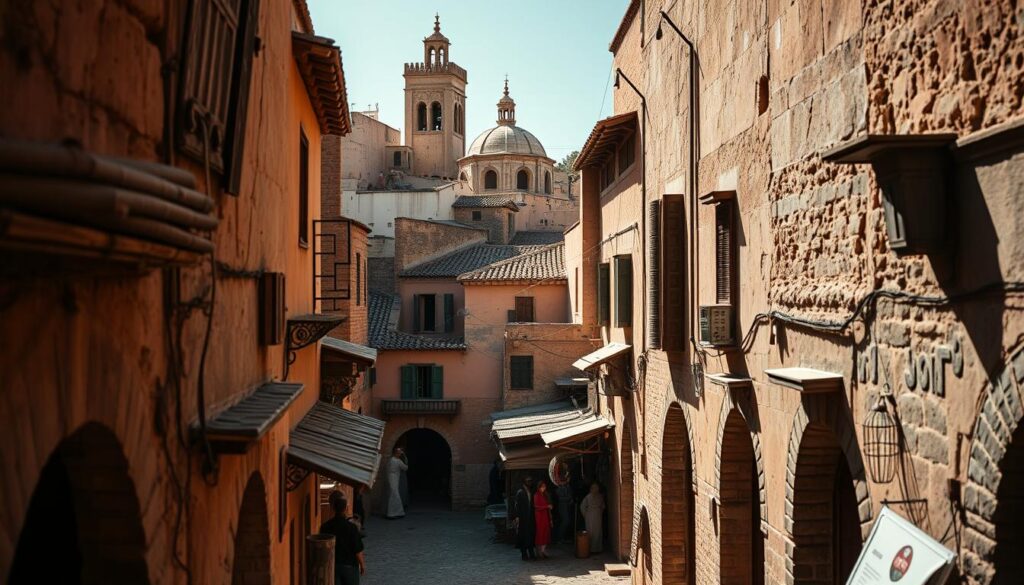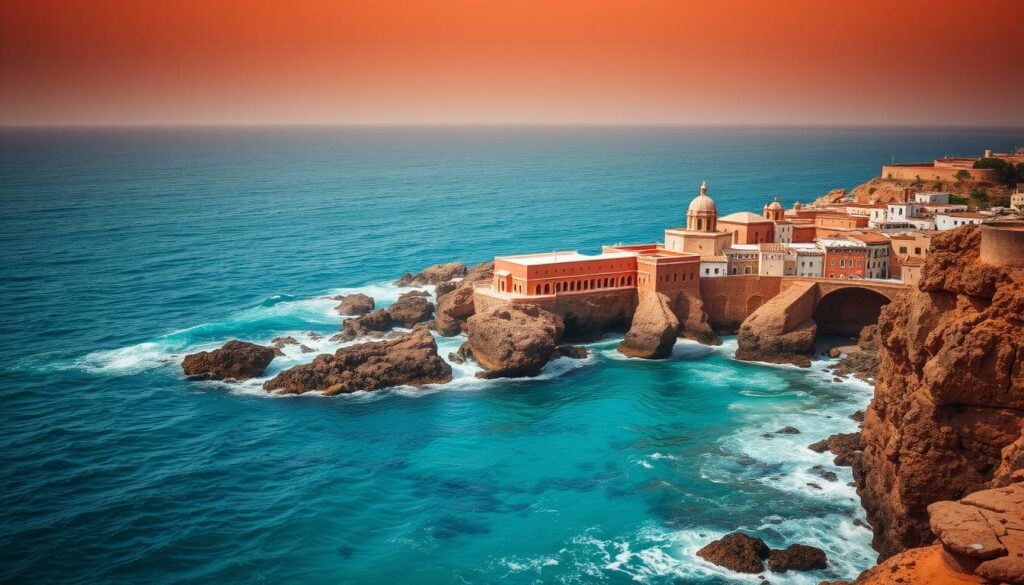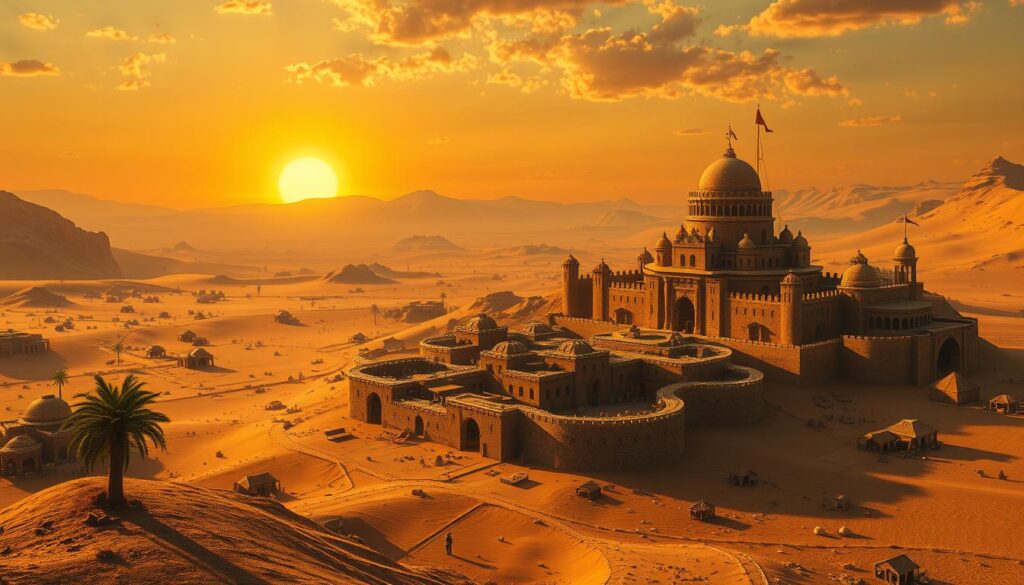Morocco is home to nine UNESCO World Heritage Sites, each a testament to the country’s rich cultural heritage and architectural diversity. With a history that spans millennia, Morocco stands at the crossroads of Amazigh, Arab, and European influences, creating a unique tapestry of cultural heritage that is unparalleled.
The country’s strategic location between Africa, Europe, and the Middle East has made it a melting pot of cultures, resulting in architectural styles and monuments that reflect its diverse history. From ancient Roman ruins to medieval Islamic cities, Morocco’s century-old sites offer a journey through time.
Key Takeaways
- Morocco has nine UNESCO World Heritage Sites, showcasing its rich cultural diversity.
- The country’s historical sites reflect a blend of Amazigh, Arab, and European influences.
- Morocco’s strategic location has contributed to its unique architectural heritage.
- The sites include ancient Roman ruins, medieval Islamic cities, and more.
- Understanding Morocco’s historical treasures provides insight into its cultural identity.
The Rich Heritage of Morocco’s Imperial Cities
With their ancient medinas and historical monuments, Morocco’s imperial cities offer a glimpse into the country’s glorious past. These cities have served as capitals during various dynasties, showcasing the pinnacle of Islamic urban planning and architecture.

Medina of Fez: Morocco’s Oldest Imperial City
The Medina of Fez is Morocco’s oldest imperial city, boasting the world’s oldest continuously operating university, the University of al-Qarawiyyin, founded in 857-859. The medina is a labyrinth of over 9,000 alleyways filled with artisanal workshops, religious schools, and historic fountains. Fez reached its golden age in the 13th-14th century as the Marinid dynasty capital, becoming one of the largest Muslim cities of its time.
Marrakech: The Red City’s Ancient Wonders
Marrakech, known as the “Red City,” is famous for its distinctive red clay walls and the iconic Koutoubia Mosque. The Koutoubia mosque’s 77-meter minaret has influenced architectural styles across North Africa and Spain. The bustling Jemaa el-Fna square serves as the heart of the city, transforming from a marketplace during the day to an open-air theater at night.
Meknes: The Legacy of Sultan Moulay Ismail
Meknes, transformed by Sultan Moulay Ismail in the 17th century, features massive granaries, stables that once housed 12,000 horses, and the impressive Bab al-Mansour gate. The city became the capital of the Alawi dynasty under Sultan Moulay Ismail, who built its defensive walls and lavish palatial complex.
UNESCO World Heritage Historical Places in Morocco
With nine UNESCO World Heritage sites, Morocco showcases its historical diversity, from ancient Roman ruins to modern urban planning. These sites not only highlight the country’s rich cultural heritage but also demonstrate its historical significance on a global scale.
Volubilis: Morocco’s Roman Legacy
Volubilis, founded in the 3rd century BCE as the capital of Mauretania, is a testament to Morocco’s Roman past. The archaeological site features well-preserved triumphal arches, intricate mosaics, and thermal baths, showcasing the extent of Roman influence in North Africa.
Rabat: A Blend of Modern Capital and Historic City
Rabat, the current capital of Morocco, has earned its UNESCO designation for its unique blend of historical and modern architecture. The city’s layout seamlessly integrates 12th-century Almohad fortifications with 20th-century French Protectorate urban designs, creating a distinctive cultural landscape.
Tétouan: The Andalusian Influence
Tétouan’s medina, nestled at the foot of the Rif Mountains, is a prime example of Andalusian influences in Morocco. Built by refugees expelled from Spain after the Reconquista, the town’s architecture and urban layout reflect a unique cultural heritage.
The designation of these sites as UNESCO World Heritage places has not only helped preserve Morocco’s diverse cultural heritage but also promoted sustainable tourism, benefiting local communities and raising awareness about the importance of historical conservation.
Coastal Historical Treasures of Morocco
Morocco’s strategic position between the Mediterranean Sea and the Atlantic Ocean has endowed its coastal regions with a wealth of historical sites. These coastal historical treasures are a testament to the country’s rich maritime heritage and cultural diversity.

Essaouira: The Windy City’s Fortified Medina
Essaouira, known as “the windy city,” is a UNESCO World Heritage site featuring a medina designed in the late 18th century. Commissioned by King Mohammed III, the fortified port city was constructed by a team of European and Moroccan architects.
The city’s distinctive blue and white color scheme, along with its grid-pattern streets, reflects the multicultural influences that shaped Essaouira. The ramparts, equipped with Dutch-made cannons, offer spectacular views of the Atlantic Ocean and the bustling fishing port.
El Jadida (Mazagan): Portuguese Colonial Heritage
El Jadida, formerly known as Mazagan, represents one of the earliest Portuguese colonial outposts in Africa. The UNESCO-listed star-shaped fortress demonstrates Renaissance military architecture principles.
The Portuguese cistern, a subterranean chamber with gothic-style columns, has become an iconic symbol of the town’s colonial heritage. The haunting reflections in the collected rainwater make it a unique historical attraction.
These coastal historical treasures not only highlight Morocco’s architectural development but also its cultural identity shaped through centuries of interaction with European powers. Visiting these sites provides a glimpse into the country’s rich history and its significance in the maritime trade.
Desert and Mountain Historical Sites

The desert and mountain regions of Morocco harbor a wealth of historical treasures that are as fascinating as they are resilient. These areas are home to numerous historical sites that showcase the country’s rich cultural heritage and architectural ingenuity.
Ksar of Ait-Ben-Haddou
The UNESCO World Heritage site of Ait-Ben-Haddou is a prime example of a fortified village in southern Morocco. Dating back to the 17th century, this ksar features earthen buildings packed closely together and defensive walls fortified by corner towers. The site’s intricate decorative motifs in clay brick demonstrate the artistic sophistication of traditional Berber architecture.
Kasbah of Taourirt
The Kasbah of Taourirt in Ouarzazate is another notable historical site, exemplifying the defensive architecture developed by powerful southern Moroccan tribes. Built entirely of straw and earth using traditional techniques, this fortress features a complex maze of passages, rooms, and courtyards that housed extended families and storage areas.
Atlas Mountains Historical Sites
The Atlas Mountains contain numerous historical sites that demonstrate how traditional Berber communities adapted their building techniques to harsh mountain environments. These settlements blend harmoniously with the dramatic landscape, showcasing the ingenuity of traditional Moroccan builders who created sustainable, climate-appropriate architecture using local materials.
Planning Your Visit to Morocco’s Historical Treasures
To fully appreciate Morocco’s historical treasures, it’s essential to plan your visit carefully, taking into account the geography and climate of the region. Morocco has nineUNESCO World Heritage Sites, all selected for their cultural significance, and a further 13 properties on the tentative list.
The country can be divided into several regions for planning purposes: the northern imperial cities, the central region around Marrakech, the Atlantic coast, and the southern desert region. The best time to visit Morocco’s historical sites is during spring (March to May) and fall (September to November) when temperatures are moderate across all regions.
Morocco’s transportation infrastructure has improved significantly, with high-speed rail connecting major cities and good roads to most historical sites. Consider allowing at least two weeks to explore Morocco’s major historical treasures, with at least two days each in Fez and Marrakech.
When visiting religious sites like theKoutoubia Mosque, visitors should be aware of dress codes and restrictions. Many historical sites charge entrance fees, and official guides can provide valuable historical context. Accommodations within or near historical sites, such as riads or kasbahs, offer a more immersive experience of Morocco’s architectural heritage.
By planning your visit carefully, you can fully appreciate the beauty and significance of Morocco’s historical treasures. With its rich cultural heritage and stunning architecture, Morocco is a destination that has something to offer for every kind of traveler.